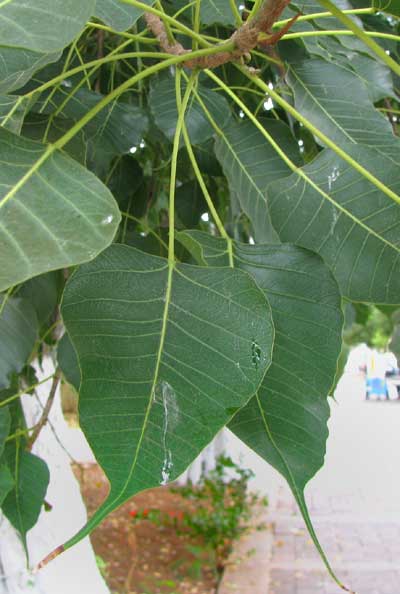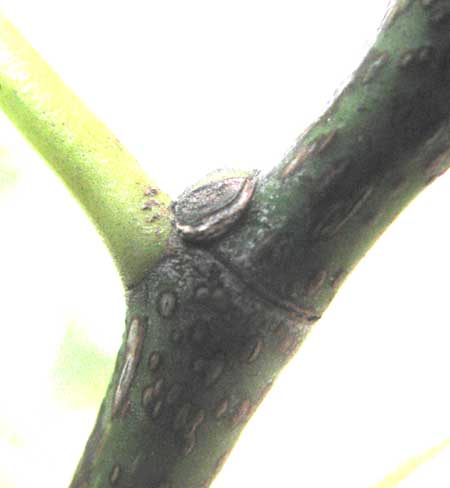Excerpts from Jim Conrad's
Naturalist Newsletter
from the April 18, 2010 Newsletter issued from Hacienda Chichen Resort beside Chichén Itzá Ruins, central Yucatán, MÉXICO; limestone bedrock, elevation ~39m (~128ft), ~N20.676°, ~W88.569°
BO-TREES
Commonly planted along Paseo de Montejo in Mérida were large, imposing trees with smooth, dark gray bark and leaves looking somewhat like cottonwood leaves, as shown below:

Noticing how certain trunks of these trees seemed to form themselves from several converging, arm-thick, woody, viny stems, it was apparent that this was a kind of strangler fig -- one of those fig species starting out as a small plant growing epiphytically in a tree, then becoming viny, and its vine stems eventually growing together, "strangling" its host, and becoming a tree, taking the place of the host tree.
And if you need more proof that we have a fig here, notice the ring around the stem where a leaf's petiole attaches to the stem below:

The ring -- typical of fig stems -- is a scar left by a "stipular ring," which is a short cylinder of tissue surrounding the young stem, created by grown-together stipules. Recently we saw such grown-together stipules on the Noni, which you can review at www.backyardnature.net/n/10/100214st.jpg.
More evidence that this is a fig is provided by the white splatters on the leaves you probably thought was bird poop. It's dried, white latex, which exudes from most fig leaves where they're injured.
Tropical America is home to several species of strangler fig. This particular one wasn't American, though, but from India and thereabouts, where it is regarded as sacred. It was the Bo-Tree, sometimes called the Peepul, FIGUS RELIGIOSA. Bo-Trees are easily identified not only by their large size and elephant-leg-like trunks, but by those more or less triangular, evergreen leaves with their long, slender tips and even longer, yellowish stems, or petioles.
This is the tree beneath which the Buddha was sitting when he "awakened." In India while backpacking in the backcountry I've seen Hindu sadhus meditating below Bo-Trees, and many Buddhist and animist shrines placed beneath, upon and within Bo-Trees.